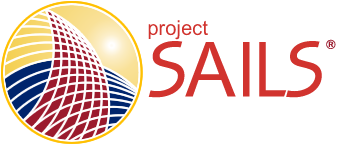SAILS is a knowledge test with multiple-choice questions targeting a variety of information literacy skills. The test items are based on the ACRL Information Literacy Competency Standards for Higher Education and Objectives for Information Literacy Instruction. Four of the five Standards are covered. Standard IV is not addressed by the SAILS tests because its competencies are not suitable for multiple-choice testing. The Individual Scores test gives an overall information literacy score for each student.
Students are directed to the SAILS web site to take the web-based test. Each student may take the test once per administration. Responses are sent to a central database where data are analyzed and reports are generated and made available for download as a spreadsheet.
Administering and taking the SAILS assessment of information literacy requires very little technical expertise. Schools register, customize the test-delivery system, and make payment online. The test is 55 questions long and most students finish within 45 minutes. You may view the question format on the sample questions page. Please also review the Terms of Use.
Reports
Participating institutions receive an institutional report, individual student reports, and associated files. The institutional report is designed to help educators identify areas of strength and areas that need improvement in their students’ knowledge of and ability to implement key information literacy outcomes and objectives. The report supports evidence-based decision-making and informs actions for strengthening student learning.
Institutional report contents:
- Overview of how students performed on the SAILS test as a whole with a single overall information literacy score for the entire testing sample and for subgroups
- Histograms that show the relative distribution of scores and provide an overall sense of how the scores fall around the mean
- Overall information literacy score for each student along with each student’s results for each item and the number correct
- Ranked list of information literacy outcomes/objectives, in order by students’ performance from the strongest to the weakest
- See sample institutional report
Student reports are individualized analysis of each student’s performance. Based on how the student answers the SAILS test questions, student reports highlight information literacy strengths and provide recommendations for improvement. Test managers have the option to display these reports to their students upon completion of the test. See sample student report.
Associated files:
- Data file containing all the scores presented in the institutional report
- Student data file with scores for each student – see sample data file
- Student data codebook that describes the demographic options configured for the test
- Student report zip file that contains the PDF documents with an analysis of each student’s performance
- The SAILS Individual Scores test questions and answers
Test Versions
There are two versions of the individual scores assessment of information literacy. Items for each test were selected based on their difficulty level, their representation of the ACRL standards, and their content.
Proficiency and Mastery
We are providing proficiency and mastery scores to provide context for your students’ performance.
70% – Proficiency Level
85% – Mastery Level
Test takers scoring a 70% or better demonstrate a proficiency level of information literacy. They demonstrate knowledge of the following components of information literacy:
- Research strategy development
- Searching basics, including Boolean operators and strategies for expanding and limiting searches
- Information retrieval
- Basics of information evaluation
- Finding tool selection and use
- Basic understanding of source documentation
- Basic understanding of the role of the academic library in information literacy
Test takers scoring an 85% or better demonstrate a mastery level of information literacy. In addition to the knowledge demonstrated at the proficiency level, they demonstrate knowledge of the following components of information literacy:
- Advanced searching, including the use of controlled vocabularies
- Advanced understanding of source documentation
- Basic understanding of Intellectual property issues involved in the use of information
Students scoring above the mastery level (85%) demonstrate some additional knowledge. Higher scoring students can demonstrate knowledge of the following components of information literacy:
- Advanced understanding of intellectual property issues involved in the use of information
- Advanced information evaluation
- Advanced understanding of the role of the academic library in information literacy
If you are interested in using SPSS to analyze your Individual Scores data, you can download our Basic Guide to Analyzing Individual Scores Data with SPSS PDF document.
Determination of Cut Scores
The Bookmark standard setting method was used to set cut scores for performance levels on the SAILS Individual Scores Test. The method is based in item response theory analysis and is widely accepted as a valid approach for determining cut scores when the item difficulties are known. We calculated item difficulties using the Rasch model of item response theory.
We used a modified Bookmark standard-setting procedure. Rather than use two rounds of rater point-setting and discussion, we established a preliminary line in the test based on the mean plus one standard deviation. We were able to make that decision because the item difficulties were normally distributed.
We then arranged the items and corresponding objectives in descending order of item difficulty, and used the data-driven cut line as a starting point for what is traditionally the third-round discussion regarding which of the objectives should be demonstrated to show proficiency and then mastery. Once we reached agreement on the cut scores, we examined a sample of test-taker data to see what impact the cut scores would have on the test takers. These conversations and analyses reflect the typical determinations made during the third round of bookmark standard-setting.
Next Up: Project SAILS Skill Sets
